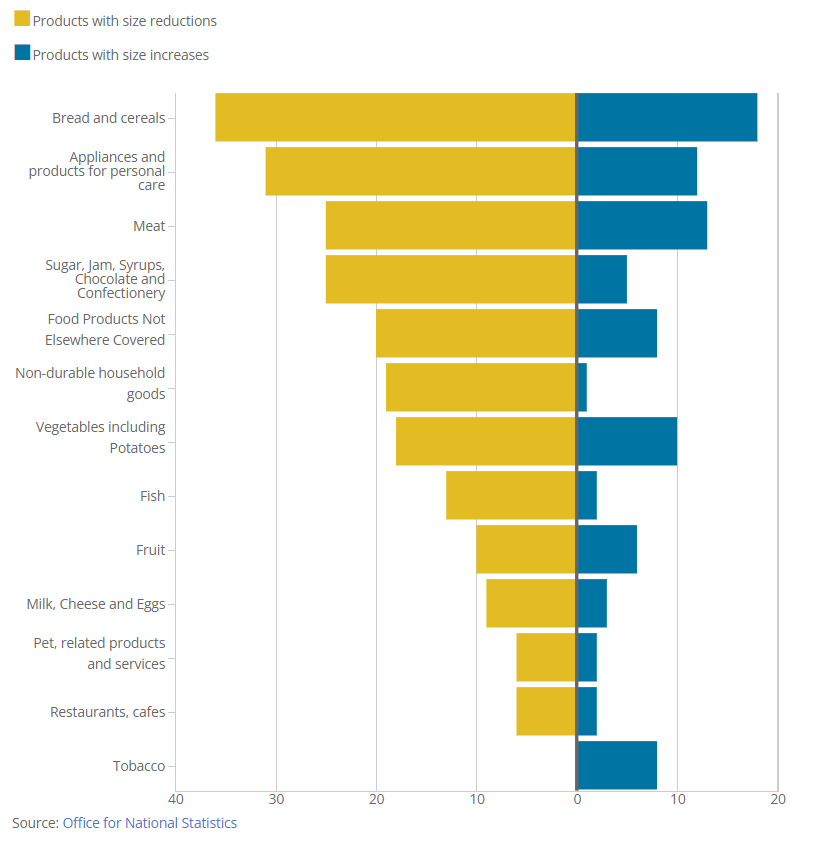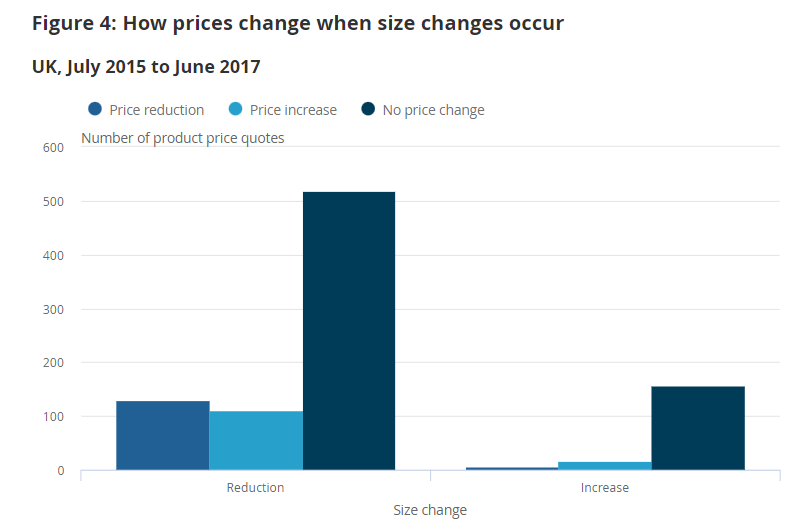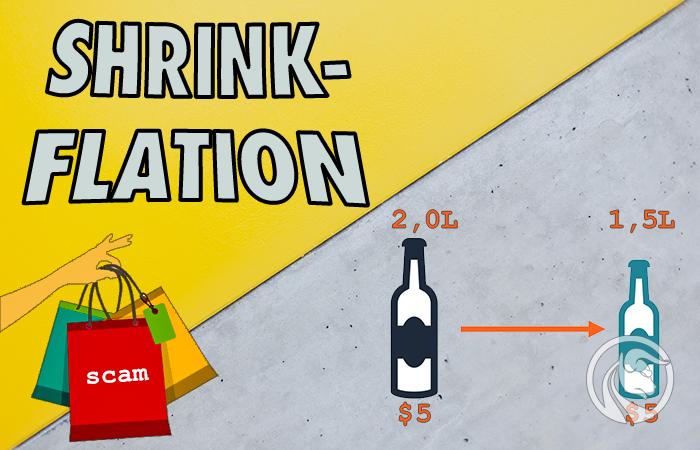Shrinkflation - hidden inflation or fraudulent practice of producers?
A period of high inflation is very hard for both consumers and producers. Producers are struggling with higher labor costs, while consumers are experiencing a decline in purchasing power. It is particularly important for producers to be able to pass costs on to consumers. Thanks to this, it is possible to maintain margins at an unchanged level, despite increasing production costs. It is not always possible to pass costs on to customers in the classic way, i.e. by increasing prices. Customers, especially those with lower incomes, are "accustomed" to the prices for products. They can react to the increase by looking for a cheaper substitute of similar quality. For this reason, some companies approach this issue in a completely different way, for example by reducing the size of their products. Today's text is about the concept shrinkflationwhich describes the producers' strategy.
Shrinkflation - what is it?
The phenomenon of reducing the size of a product due to an increase in production costs is called shrinkflation. It is a conflation of two English words: shrink and flattening. Shrink is associated with a reduction in package size, while the flation ending is part of the word inflation. Deadline shrinkflation was propagated by a British economist Pippa Malmgren.
Consumers are generally visual learners. For this reason the most important thing for the manufacturer is to keep the price unchanged i designing a new packaging in such a way that the visual size of the product is at a similar level. For this reason, the new packaging designs are more "slim" or have convex bottoms. Of course, manufacturers put information about the new weight of the product. However, very often it is not placed in a visible place, but hidden, for example, at the back. Theoretically, the manufacturer does not cheat the customer, because he informs about the actual weight or volume. However, customers most often do not look closely at food packaging.
Producers benefit from such a strategy because they do not change their prices but reduce production costs. Of course, the reduction in production costs is a response to the increase in the cost of materials. For this reason, downsizing does not cause the company to increase its profits but tries to keep its margins unchanged. It is worth noting that very often a reduction in the size of products is imitated by the competition.
In today's world, reducing the size of products is quickly exposed by customers. Information about the reduction in the size of the products is spread rapidly via social media.
PPA - one of the reasons for using shrinkflation
Many companies associate their decisions related to the size of the packaging and its price with using the PPA (Price Pack Architecture) methodology. This analytical method allows companies and brands to offer relevant products that meet customer expectations at a specific price. Properly conducted PPA allows you to increase the willingness of consumers to consume products. To determine the optimal price per package, the brand owner must answer the following questions:
- What product features and benefits are consumers willing to pay a certain price for?
- What can convince customers to pay more for the product?
- Are consumers willing to pay more for a smaller line of packaging?
- What price should I set for new products to maximize sales of all products of the brand?
- How will the new products compete with the brand's current offering?
- How much can the new product cannibalize current products?
To answer the following questions, the company needs to know the needs of customers and their assets. Research on customer purchasing mechanisms is also important. The aforementioned PPA strategy allows you to answer the question of whether the company should increase the price for its products or reduce the size of the package. The decision is intended to maximize brand sales while maintaining the loyalty of key consumers of a given product.
The increase in production costs is one of the reasons for shrinkflation
Manufacturers of consumer goods - especially food - take advantage of the reduction in the size of packaging as a result of the increase in production costs. There can be many reasons for the increase in production costs. The most important of them include:
- Increase in raw material prices,
- Higher labor costs,
- Increase in energy prices,
- Raising taxes.
Rising raw material costs are often the bane of manufacturers who are not vertically integrated. Often, food producers cannot change the ingredient without compromising the quality of the product. It is hard to imagine that well-known orange juice producers would stop using oranges in their drinks. As a result, a permanent increase in the price of oranges causes an increase in the cost of the "input" needed to produce the juice.
Higher labor costs are particularly significant where the production method requires a large number of workers. The higher the share of salaries in operating costs, the more sensitive the company is to salary increases in the economy. In the short term, the company cannot optimize labor costs. As a result, an increase in wages causes an increase in labor costs. The more painful the increase in employment costs is, the company will look for optimization methods. One of them is the introduction of automation or better organization of work, which will result in the reduction of employment.
An increase in energy prices may be the reason for the need to change product prices. Energy prices have a particularly strong impact if the change in electricity prices increases significantly. Another reason is the high share of energy costs in the production process. In the long term, the company can reduce energy costs by purchasing less energy-intensive machines or installing photovoltaic panels.
Increasing taxes is one of the reasons that will force the company to reduce packaging. This will be the case when consumers, due to the increase in the cost of goods, will reduce consumption. Reducing the packaging will allow you to maintain the price of the packaging despite the increase in taxation.
Such factors may force a company without strong "pricing power" to implement strategies to protect its margin. The most popular alternatives to raising the price include:
- product size reduction,
- Deterioration of product quality.
Deteriorating product quality is also a popular tactic to pass rising costs on to the customer. This means that the size of the product and its price have been left unchanged. The change concerns the quality of the ingredients. An example is the production of ketchup from less tomatoes or the replacement of sugar with a cheaper sweetener. However, this is not an example of shrinkflation. The quality reduction method is much more insidious for the customer because it is more difficult for the consumer to notice than changing the size of the package.
Market competition also affects the pricing policy
The price and volume strategies are strongly influenced by the competitive environment. If consumers can easily find a substitute, then raising the price could trigger an exodus of customers. For this reason, a slight reduction in product size may cause customers to accept the new pricing policy. This will allow you to maintain market shares and at the same time improve (or maintain) your profitability.
The larger the manufacturer's market share, the easier it is to use a downsizing strategy. This is due to the fact that a smaller player usually has to adapt its strategy to the pricing policy of the dominant companies. The best-known brands, due to their recognition, can impose their pricing policy on less recognizable competitors.
Disadvantages of Shrinkflation
While the advantages of lowering products are known, this strategy can also have significant disadvantages. One of them is the loss of consumer trust in the brand. Customers don't like being cheated. A "secret" price change by downsizing may cause customers to consider it a scam. This is very destructive to the perception of the brand in the market. Particularly dangerous are significant reductions in weight or volume of the product. Much better when reductions are made subtly and carefully.
Another disadvantage of this strategy is that it is not a long-term strategy. Eventually, the company will have to raise prices. It is impossible to reduce the weight or volume of a product indefinitely. In the long term, it is worth taking care of pricing power. Without this, it will be difficult to pass the costs on to your customers.
How not to fall for Shrinkflation?
The downsizing strategy is not ideal. It is very easy for an observant customer to discover a "hidden" price increase. Of course, the appearance of the new packaging is designed so that a change in volume or weight is difficult to observe visually. But this manufacturer's solution is not perfect. Just look at the weight or volume markings of the product. It is worth paying attention to new packaging shapes or new slogans. Another way is to look at prices per unit (kilogram, liter, piece). However, this requires the consumer to keep a record of changes in purchase prices.
If the customer does not like the policy of changing the size of the package, he can use products of other brands. Another idea is to use stores' own brands, which are usually cheaper than "branded" products. Then the shrinkflation strategy will fail as customers switch to competitors' products.
Examples of shrinkflation
Interestingly, some statistical offices have conducted studies on shrinkflation. One of them is the ONS (Office for National Statistics), which is a British government agency that collects and processes information about the economy of the United Kingdom. According to an article written in 2019, the ONS tested a sample of products that make up the calculation CPI inflation for shrinkflation. According to research in the years 2015-2017, it was reported that 206 products decreased in weight or volume, while 79 products increased in size. In the case of products from the food and beverage group, a decrease in the size of the product sold was reported in 2,1% of the sample tested. An increase in product size was reported in 0,7% of them.

The ONS also investigated how the price changes when the package size changes. The analysis took into account both the reduction and increase in the weight of the offered product. As can be seen in the chart below, the pricing policy of producers was dominated by the strategy of not changing prices.

Source: ONS
Interestingly, shrinkflation also applies to enterprises with recognizable consumer brands. A very interesting example is Mars Inc, which in 2017 decided to reduce the packaging of Maltesers and M&Ms by 15% in the United Kingdom. The reason was the increase in cocoa prices, which could not be quickly passed on to the customer.
Also in 2022 there are numerous examples of shrinkflation. Corn Flakes, which are produced by the American Kellogg's, are an example. The weight of the package has been reduced from 760 grams to 600 grams. Another example is Sour Punch, which has reduced the weight of its sweets from 128g to 91g. The maneuver of changing the size of the product and leaving the price was also used by Frito-Lay, a company owned by Pepsi. Doritos pack decreased from 9,75 oz. Up to 9,25 oz. The price of the product did not change and amounted to $4,29.






















![Forex Club – Tax 9 – Settle tax on a foreign broker [Download the Application] Forex Club - Tax 9](https://forexclub.pl/wp-content/uploads/2024/02/Forex-Club-Podatek-9-184x120.jpg?v=1709046278)
![Trading View platform – solutions tailored to the needs of traders [Review] trading view review](https://forexclub.pl/wp-content/uploads/2024/03/trading-view-recenzja-184x120.jpg?v=1709558918)
![How to connect your FP Markets account to the Trading View platform [Guide] fp markets trading view](https://forexclub.pl/wp-content/uploads/2024/02/fp-markets-trading-view-184x120.jpg?v=1708677291)
![How to invest in ChatGPT and AI? Stocks and ETFs [Guide] how to invest in chatgpt and artificial intelligence](https://forexclub.pl/wp-content/uploads/2023/02/jak-inwestowac-w-chatgpt-i-sztuczna-inteligencje-184x120.jpg?v=1676364263)


![WeWork – the anatomy of the collapse of a company valued at $47 billion [WeWork, part II] wework bankruptcy story](https://forexclub.pl/wp-content/uploads/2024/04/wework-bankructwo-historia-184x120.jpg?v=1711729561)
![Adam Neumann – the man who screwed up Softbank [WeWork, part AND] adam neumann wework](https://forexclub.pl/wp-content/uploads/2024/04/adam-neumann-wework-184x120.jpg?v=1711728724)





![How to transfer shares to another brokerage office [Procedure description] how to transfer shares to another brokerage house](https://forexclub.pl/wp-content/uploads/2024/03/jak-przeniesc-akcje-do-innego-biura-maklerskiego-184x120.jpg?v=1709556924)

![The most common mistakes of a beginner trader - Mr Yogi [VIDEO] Scalping - The most common mistakes of a beginner trader - VIDEO](https://forexclub.pl/wp-content/uploads/2024/03/Scalping-Najczestsze-bledy-poczatkujacego-tradera-VIDEO-184x120.jpg?v=1711601376)
![Learning patience: No position is also a position - Mr Yogi [VIDEO] Scalping - Learning patience - No position is also a position - VIDEO](https://forexclub.pl/wp-content/uploads/2024/03/Scalping-Nauka-cierpliwosci-Brak-pozycji-to-tez-pozycja-VIDEO-184x120.jpg?v=1710999249)
![When to exit a position and how to minimize losses - Mr Yogi [VIDEO] Scalping - When to exit a position and how to minimize losses - VIDEO](https://forexclub.pl/wp-content/uploads/2024/03/Scalping-Kiedy-wyjsc-z-pozycji-i-jak-minimalizowac-straty-VIDEO-184x120.jpg?v=1710336731)

















